
Welcome to
Azur Electronics
Azur Electronics
HP 1630D LOGIC ANALYSER
Home
Projects
Test Equipment
- Accessories
- Adaptors
- Amplifiers
- Attenuators
- Cables
- Frequency Counters
- Logic Analysers
- Multi-Meters
- Network Analysers
- Oscilloscopes
- Power Meters
- Power Supplies
- Prototyping Equipment
- Signal Generators
- Spectrum Analysers
- Tools
Operating Information
- Operating HP 141T
- Operating HP 1630D
- Operating HP 8175A
- Operating HP 8407A
- Operating HP 8410C
- Operating HP 8552B IF Section
- Operating HP 8553B RF Section
- Operating HP 8554B RF Section
- Operating HP 8555A RF Section
- Operating HP 8556A LF Section
- Operating HP 8594E Spectrum Analyser
- Operating HP 8901B
- Operating LeCroy 9310
Technical
- Allen Key Sizes
- High Voltage Measurement
- HP Cases
- HP Information
- HP-IB Interface Bus
- Measurement Units
- Motorola ECL
- RF Connectors
- RF Power - Voltage Conversion
For Sale
Wanted
Links
About Me
Contact Me
Site Map
This HP 1630D Logic Analyser has 6 State Connections (3 Master & 3 Slave) and 1 Timing Connection. These are complete with their respective pods/probes. The standard 1630D has a Timing Slave Board instead of the State Slave Board, so this Logic Analyser has been modified to convert it to a 1630G version. There is also a 1630A version with no slave boards. In 1987, the 1630A cost $8,600, the 1630D $10,630, the 1630G $12,100. The upgrade kit from 1630A-D to G cost $3,450.
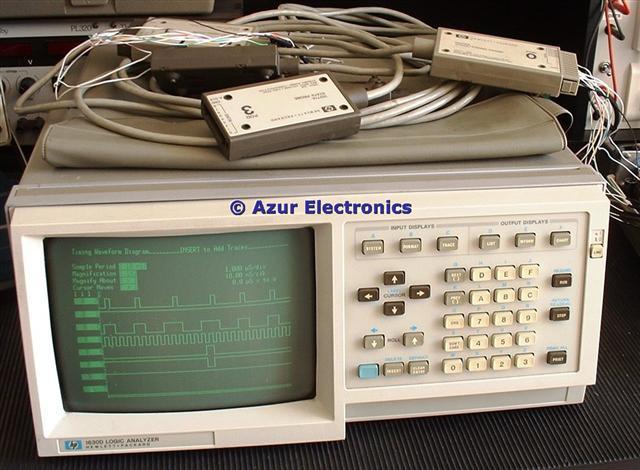
Front Panel showing push-button controls
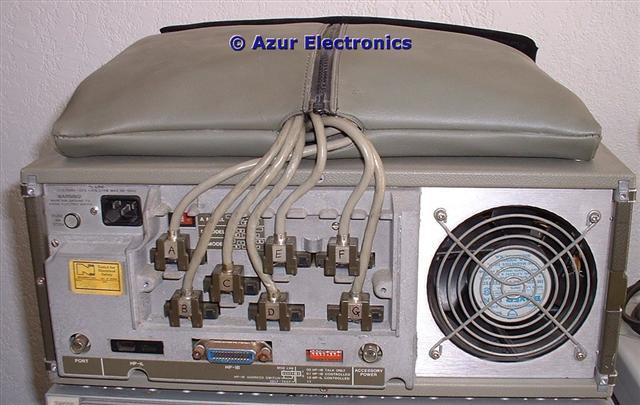
Rear Panel showing Pod connections
At the bottom of the rear panel are: 'PORT' BNC socket which can be programmed for various output signals; 'HP-IL' (HP Interface Loop) plug and socket for connecting a mini-cassette drive; 'HP-IB' (HP Interface Bus) 24 way Amphenol socket for connecting a controller, printer, disc memory, etc; 8 position Switch for HP-IB addressing; and 'ACCESSORY POWER' BNC socket providing +5V.
June 2007
This was bought on eBay and arrived damaged as it was not very well packed, plus the box had probably been dropped or thrown about. Amazingly, only the plastic front panel was hanging off the chassis and the fragile CRT was undamaged. Some repair work was therefore required. For details see Repair HP 1630D Logic Analyser. The Logic Analyser now powers-up and passes all its self-test routines.
I have not used a logic analyser before but realised their use in fault finding complex logic circuits, so this was a good opportunity to learn something new.
3 comprehensive Manuals (148 + 507 + 164 pages) were downloaded from the web which should keep me busy for several years! Maybe one day I will understand it all.
August 2009
Started on reading the manuals at last (as temporarily held up on another project waiting for spare parts). Evaluating the State setup requires a microprocessor driven circuit with 16 address lines, 8 data lines, clocks and control signals. Evaluating the Timing setup only needs a logic circuit to provide the necessary signals. Both setup conditions appear to be functioning ok but detailed tests have not yet been carried out.
June 2007
This was bought on eBay and arrived damaged as it was not very well packed, plus the box had probably been dropped or thrown about. Amazingly, only the plastic front panel was hanging off the chassis and the fragile CRT was undamaged. Some repair work was therefore required. For details see Repair HP 1630D Logic Analyser. The Logic Analyser now powers-up and passes all its self-test routines.
I have not used a logic analyser before but realised their use in fault finding complex logic circuits, so this was a good opportunity to learn something new.
3 comprehensive Manuals (148 + 507 + 164 pages) were downloaded from the web which should keep me busy for several years! Maybe one day I will understand it all.
August 2009
Started on reading the manuals at last (as temporarily held up on another project waiting for spare parts). Evaluating the State setup requires a microprocessor driven circuit with 16 address lines, 8 data lines, clocks and control signals. Evaluating the Timing setup only needs a logic circuit to provide the necessary signals. Both setup conditions appear to be functioning ok but detailed tests have not yet been carried out.
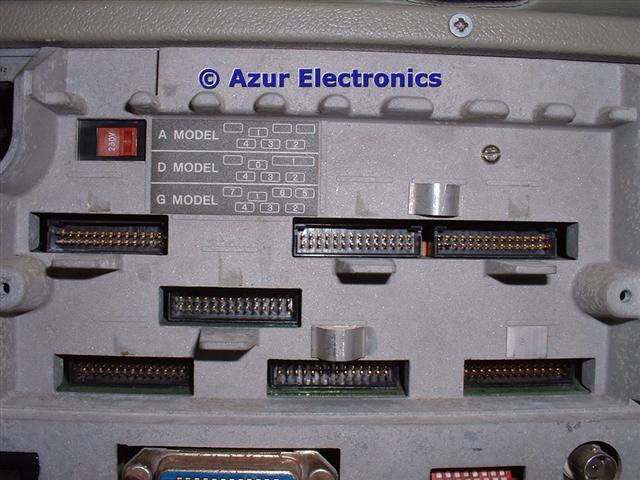
Detail of Rear Panel Pod Connections
NOTE: Take great care connecting the Pods to the Rear Panel connectors as the pins are easily bent. This shows up as "Aquisition Errors" on the self-test routine.
Differences between the A, D & G Versions (what happened to B & C ?).
The HP 1630A has only the A4 Master State Board (lower position) and the A5 Master Timing Board (middle position) fitted. The top position is therefore blank.
3 off HP 10271A State Probes, Pods 4, 3 & 2 are fitted to the lower Board.
1 off HP 10272A State/Timing Probe, Pod 1 is fitted to the middle Board.
This provides 27 state channels (3 x 9), 3 clock channels and 8 timing channels.
The HP 1630D has the A4 Master State Board (lower position), the A5 Master Timing Board (middle position) and the A8 Timing Slave Board (top position) fitted.
3 off HP 10271A State Probes, Pods 4, 3 & 2 are fitted to the lower Board.
1 off HP 10272A State/Timing Probe, Pod 0 is fitted to the middle Board.
1 off HP 10272A State/Timing Probe, Pod 1 is fitted to the top Board.
This provides 0, 27, 35, or 43 state channels, 3 clock channels and 0, 8 or 16 timing channels.
The HP 1630G has the A4 Master State Board (lower position), the A5 Master Timing Board (middle position) and the A11 State Slave Board (top position) fitted.
3 off HP 10271A State Probes, Pods 4, 3 & 2 are fitted to the lower Board.
1 off HP 10272A State/Timing Probe, Pod 1 is fitted to the middle Board.
3 off HP 10273A State Probe, Pods 7, 6 & 5 are fitted to the top Board.
This provides 0, 57 or 65 state channels, 3 clock channels and 0 or 8 timing channels.
Differences between the A, D & G Versions (what happened to B & C ?).
The HP 1630A has only the A4 Master State Board (lower position) and the A5 Master Timing Board (middle position) fitted. The top position is therefore blank.
3 off HP 10271A State Probes, Pods 4, 3 & 2 are fitted to the lower Board.
1 off HP 10272A State/Timing Probe, Pod 1 is fitted to the middle Board.
This provides 27 state channels (3 x 9), 3 clock channels and 8 timing channels.
The HP 1630D has the A4 Master State Board (lower position), the A5 Master Timing Board (middle position) and the A8 Timing Slave Board (top position) fitted.
3 off HP 10271A State Probes, Pods 4, 3 & 2 are fitted to the lower Board.
1 off HP 10272A State/Timing Probe, Pod 0 is fitted to the middle Board.
1 off HP 10272A State/Timing Probe, Pod 1 is fitted to the top Board.
This provides 0, 27, 35, or 43 state channels, 3 clock channels and 0, 8 or 16 timing channels.
The HP 1630G has the A4 Master State Board (lower position), the A5 Master Timing Board (middle position) and the A11 State Slave Board (top position) fitted.
3 off HP 10271A State Probes, Pods 4, 3 & 2 are fitted to the lower Board.
1 off HP 10272A State/Timing Probe, Pod 1 is fitted to the middle Board.
3 off HP 10273A State Probe, Pods 7, 6 & 5 are fitted to the top Board.
This provides 0, 57 or 65 state channels, 3 clock channels and 0 or 8 timing channels.
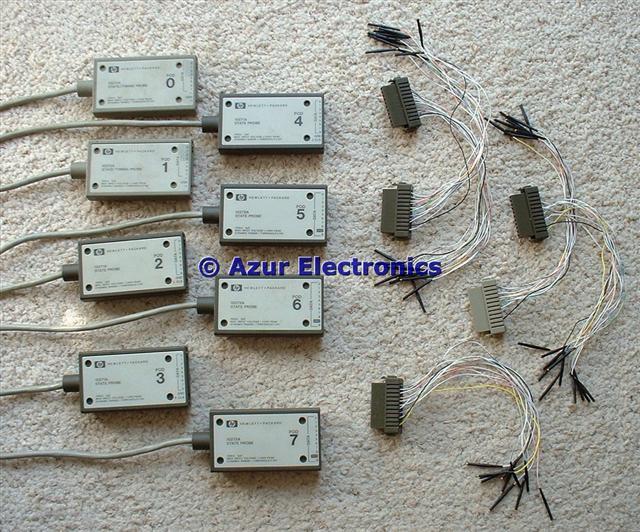
Pods and Interface Cables
I have all 8 Pods but am missing some of the interface cables. I need 1 more 9 way interface cable for Pod 0 or 1, HP 10272A and 2 more 11 way interface cables for Pods 5 to 7, HP 10273A. Now obtained, see below.
I was considering obtaining a A8 Timing Slave Board to exchange it with the A11 State Slave Board in the top position, thereby converting from 1630G to 1630D as required. This is not possible unless a new set of ROMs for the A3 CPU Board are changed as well, or both types of CPU Board are available.
As these accessories get lost over the years, it will probably be easiest to acquire another 1630D with Pods and cables. This will also give me a source of spare parts. Now obtained, see below.
I was considering obtaining a A8 Timing Slave Board to exchange it with the A11 State Slave Board in the top position, thereby converting from 1630G to 1630D as required. This is not possible unless a new set of ROMs for the A3 CPU Board are changed as well, or both types of CPU Board are available.
As these accessories get lost over the years, it will probably be easiest to acquire another 1630D with Pods and cables. This will also give me a source of spare parts. Now obtained, see below.
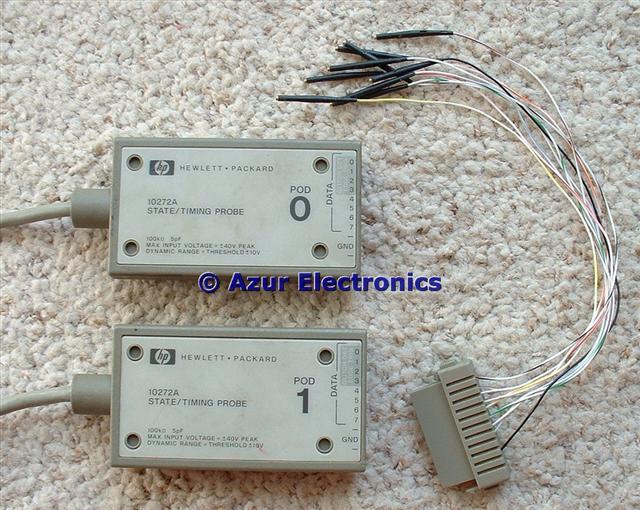
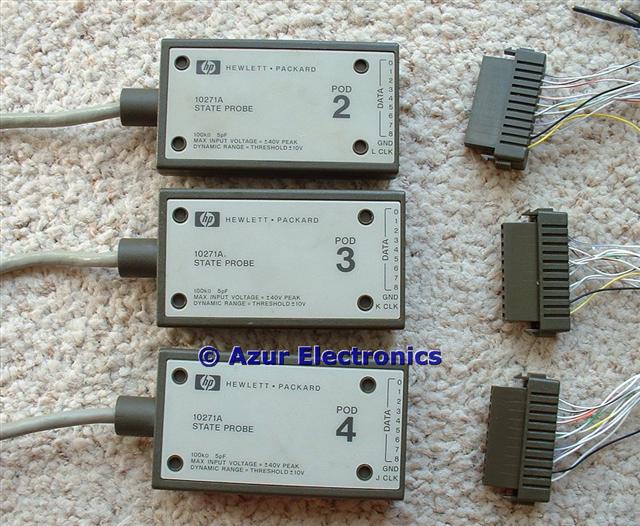
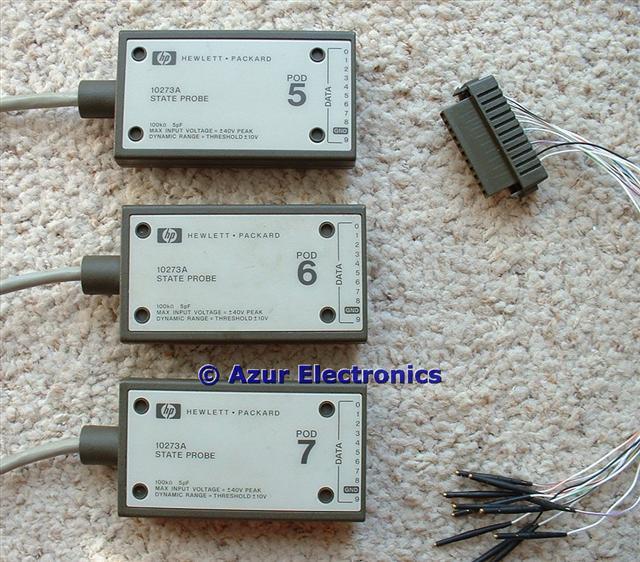
Pods 0 & 1 have 8 data and 1 ground signal.
Pods 2 to 4 have 9 data, 1 ground and 1 clock signal (L, K & J clocks respectively).
Pods 5 to 7 have 10 data and 1 ground signal.
Pods 2 to 4 have 9 data, 1 ground and 1 clock signal (L, K & J clocks respectively).
Pods 5 to 7 have 10 data and 1 ground signal.
April 2010
Bought a second 1630D Logic Analyser. Also bought a lot of 40 IC Test Clips which fit the Logic Analyser test cables perfectly.
June 2010
Bought a second 1630D Logic Analyser. Also bought a lot of 40 IC Test Clips which fit the Logic Analyser test cables perfectly.
June 2010
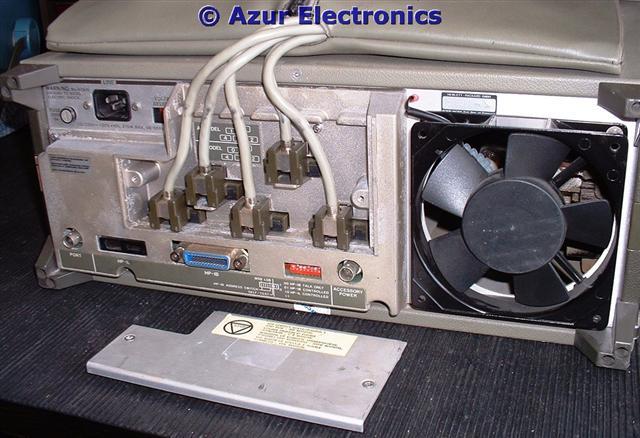
2nd HP 1630D Rear Panel
The second HP 1630D has a few minor differences: the fan is on the outside of the case and the guard is missing; the correct rear plate is fitted; there are only 5 Pod connections. The Pods supplied are 0,1,2,3,4 (see above) but missing the interface cables. This Logic Analyser needs checking out before I decide what to do with it.
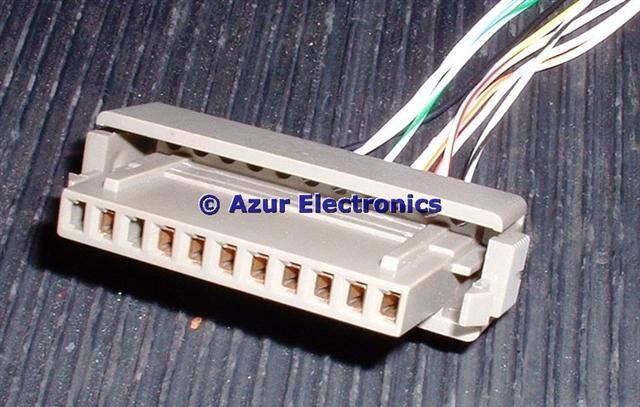
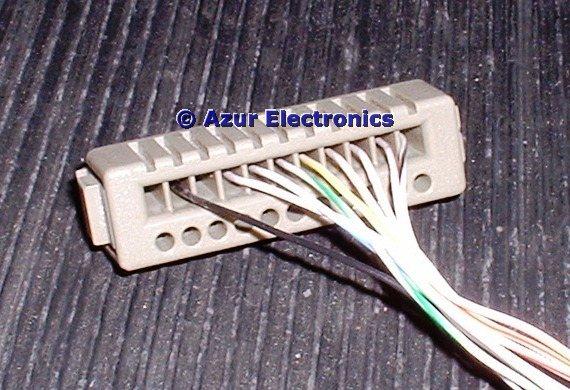
Interface cable connector
The interface cables are 11 way sockets with either 9 or 11 contacts fitted which are wired to pin sockets, which in turn can fit an IC Pin or Grabber. With 9 contacts fitted they have a light grey body and for 11 contacts they have a dark brown body to match the Pod colours, amazing HP design detail! I think the part numbers are 10271-63201, 10272-63201, 10273-63201 for the assemblies. Spare interface cables have now been obtained.
July 2010
The second HP 1630D powers-up ok and passes its self-test routines. It is a later serial number than the first unit and generally in slightly better condition. It is a bit dirty inside, so needs stripping down, cleaning-up and re-assembling. Before I do this, I want to understand the operation and applications of the Logic Analyser, see Operating HP 1630D Logic Analyser.
September 2010
Have now bought 5 more Pods (0 to 4) together with their interface cables (thanks to Steve K) plus an original Manual for the 1630A/D of October 1983 which has readable screen shots unlike the .pdf Manuals.
Now have 1 set of Pods 0 to 7, 2 sets of Pods 0 to 4, 3 off 9 way Interface cables, 7 off 11 way Interface cables and 40 off IC Grabbers. 1 set of the Pods 0 to 4 are spare and can be resold, see HP 1630D Parts, now SOLD.
December 2010
Stripped down the second HP 1630D to assembly level, cleaned all the dust out and re-assembled. A few minor issues with screws missing, CRT earth pin not properly connected, and fan correctly fitted to the inside although a fan guard is still required.
July 2010
The second HP 1630D powers-up ok and passes its self-test routines. It is a later serial number than the first unit and generally in slightly better condition. It is a bit dirty inside, so needs stripping down, cleaning-up and re-assembling. Before I do this, I want to understand the operation and applications of the Logic Analyser, see Operating HP 1630D Logic Analyser.
September 2010
Have now bought 5 more Pods (0 to 4) together with their interface cables (thanks to Steve K) plus an original Manual for the 1630A/D of October 1983 which has readable screen shots unlike the .pdf Manuals.
Now have 1 set of Pods 0 to 7, 2 sets of Pods 0 to 4, 3 off 9 way Interface cables, 7 off 11 way Interface cables and 40 off IC Grabbers. 1 set of the Pods 0 to 4 are spare and can be resold, see HP 1630D Parts, now SOLD.
December 2010
Stripped down the second HP 1630D to assembly level, cleaned all the dust out and re-assembled. A few minor issues with screws missing, CRT earth pin not properly connected, and fan correctly fitted to the inside although a fan guard is still required.
The A1 low voltage PSU is the later 01630-66514 pcb.
Powered-up and all the voltage rails are ok. There is a test connector at the top left corner of the photo.
There were some reliability issues with these PSU's, see Repair HP 1630D Logic Analyzer for details and explained in the Service Manual.
Powered-up and all the voltage rails are ok. There is a test connector at the top left corner of the photo.
There were some reliability issues with these PSU's, see Repair HP 1630D Logic Analyzer for details and explained in the Service Manual.
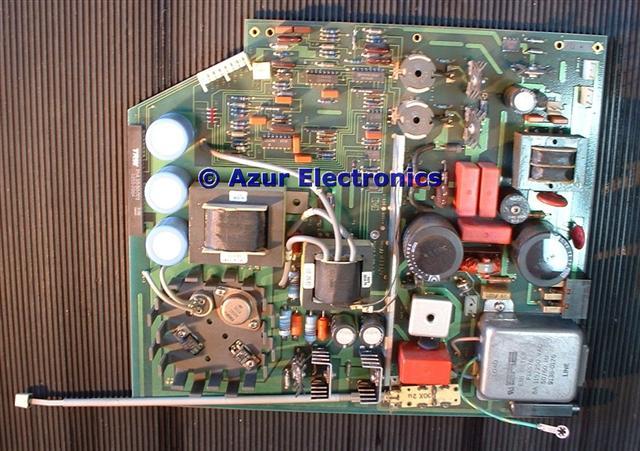
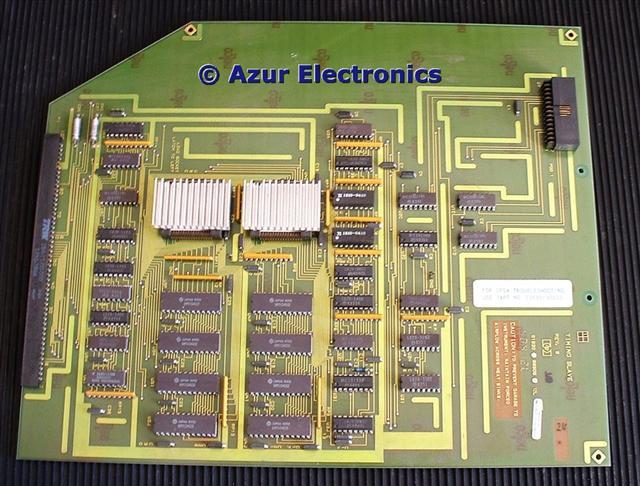
The 1630D has a A8 Timing Slave Board fitted 01630-66508 to provide the additional 8 timing channels.
The 1630G has the A11 State Slave Board fitted instead.
The 1630G has the A11 State Slave Board fitted instead.
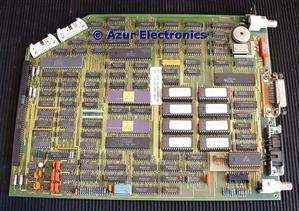
The A3 CPU Board is the later 01630-66512 and the 8 ROMs 01630-80008 to 80015.
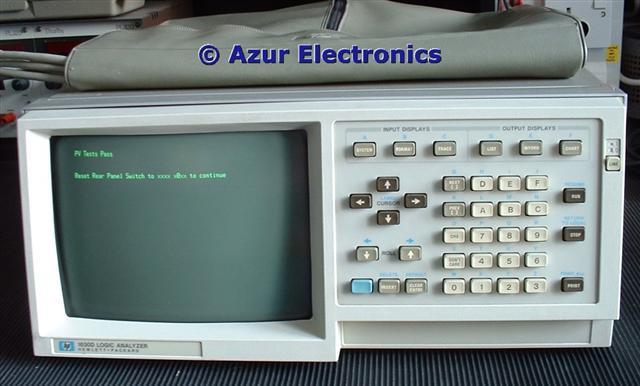
Performance Verification
Self Test (Performance Verification) checks the RAM, ROM and ability to make state measurements. This is activated by switch 6 on the rear panel. These all passed ok.
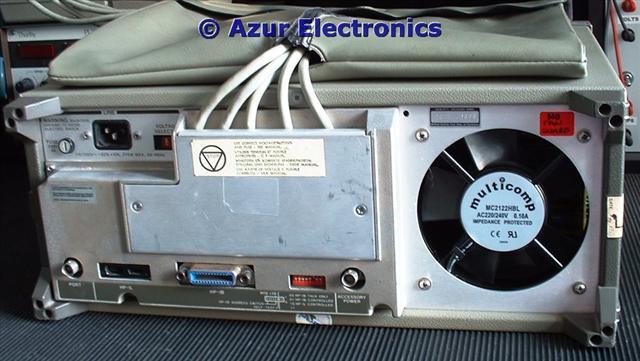
Must fit a fan guard!!!
The HP Catalogue for 1986 lists the 1630D for hardware analysis and debug of 16-bit microprocessors with up to 43 state channels and 16 timing channels. The 1630G is intended for 16-bit microprocessor software analysis with up to 65 state channels and 8 timing channels, plus the ability to store setup configuration and data.
The benefits of 16 timing channels are obvious when compared to an Oscilloscope's 2 or 4 channels. Evaluation of the state channels are held up pending the acquisition of the HP 5036A Microprocessor Lab, or something equivalent, to carry out further tests. I can then decide whether to keep the 1630D or G, or both!
March 2011
Bought HP 5036A Microprocessor Lab so now have the equipment to carry out State tests.
June 2012
Bought 3rd HP 1630D for spares including the rear connector plate and a fan guard. This is a slightly earlier unit but complete, except that the Pods and cables were cut off from the rear connectors! Fitting spare Pods then powering-up and passes Self Test.
July 2012
Used the fan guard and rear corners on the 2nd 1630D. The connector plate is a different size between the D and G versions so not interchangable. Apart from the fan guide, the 3rd 1630D is complete with replacement Pods so could be sold, now SOLD.
July 2014
Bought a HP 8175A Digital Signal Generator for use with these Logic Analysers.
April 2015
The original 1630G has failed with inconsistent start up sequence which then hangs. The fault is on the CPU board. The self test routine shows the RAM and ROM are ok. Decided to strip down the 'G' and 2nd 'D' units then use the latest version of the assemblies to rebuild a 1630G. This involved swopping over the 8 ROM set to the good CPU board. Now have a working 'G' unit again.
The 'D' version provides up to 43 state channels and up to 16 timing channels. The 'G' version provides up to 65 state channels and up to 8 timing channels, plus the ability to store configuration setup.
I also have lots of spare parts from the scrapped unit, see HP 1630D Parts. Not sure if both working units are still needed but this should become clear after completing the testing and operations work with the HP 5036 Microprocessor Lab, the HP 8175A Digital Signal Generator and with my PIC development work.
November 2016
Checking all the specialist batteries in my test equipment, see Batteries In Test Equipment. I thought that because the 1630G stores the configuration setup in RAM that it had a backup battery. I can't find a battery on the A3 CPU Board so suspect that the configuration setup is written to ROM. Nothing in the Manuals about this, so will need to investigate further.
March 2018
Completed Confidence Tests for the 1630D and 1630G.
October 2019
Completed working through the Operating and Programming Manual for State Measurements. see Operating HP 1630D Logic Analyser.
The 1630D and 1630G, although nearly 40 years old, are powerful multi-channel Logic Analysers which are still fit for purpose for my needs. To get the best out their comprehensive features, reading the Manuals is recommended.
The benefits of 16 timing channels are obvious when compared to an Oscilloscope's 2 or 4 channels. Evaluation of the state channels are held up pending the acquisition of the HP 5036A Microprocessor Lab, or something equivalent, to carry out further tests. I can then decide whether to keep the 1630D or G, or both!
March 2011
Bought HP 5036A Microprocessor Lab so now have the equipment to carry out State tests.
June 2012
Bought 3rd HP 1630D for spares including the rear connector plate and a fan guard. This is a slightly earlier unit but complete, except that the Pods and cables were cut off from the rear connectors! Fitting spare Pods then powering-up and passes Self Test.
July 2012
Used the fan guard and rear corners on the 2nd 1630D. The connector plate is a different size between the D and G versions so not interchangable. Apart from the fan guide, the 3rd 1630D is complete with replacement Pods so could be sold, now SOLD.
July 2014
Bought a HP 8175A Digital Signal Generator for use with these Logic Analysers.
April 2015
The original 1630G has failed with inconsistent start up sequence which then hangs. The fault is on the CPU board. The self test routine shows the RAM and ROM are ok. Decided to strip down the 'G' and 2nd 'D' units then use the latest version of the assemblies to rebuild a 1630G. This involved swopping over the 8 ROM set to the good CPU board. Now have a working 'G' unit again.
The 'D' version provides up to 43 state channels and up to 16 timing channels. The 'G' version provides up to 65 state channels and up to 8 timing channels, plus the ability to store configuration setup.
I also have lots of spare parts from the scrapped unit, see HP 1630D Parts. Not sure if both working units are still needed but this should become clear after completing the testing and operations work with the HP 5036 Microprocessor Lab, the HP 8175A Digital Signal Generator and with my PIC development work.
November 2016
Checking all the specialist batteries in my test equipment, see Batteries In Test Equipment. I thought that because the 1630G stores the configuration setup in RAM that it had a backup battery. I can't find a battery on the A3 CPU Board so suspect that the configuration setup is written to ROM. Nothing in the Manuals about this, so will need to investigate further.
March 2018
Completed Confidence Tests for the 1630D and 1630G.
October 2019
Completed working through the Operating and Programming Manual for State Measurements. see Operating HP 1630D Logic Analyser.
The 1630D and 1630G, although nearly 40 years old, are powerful multi-channel Logic Analysers which are still fit for purpose for my needs. To get the best out their comprehensive features, reading the Manuals is recommended.